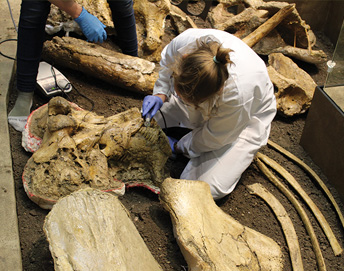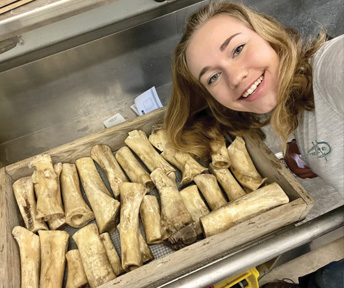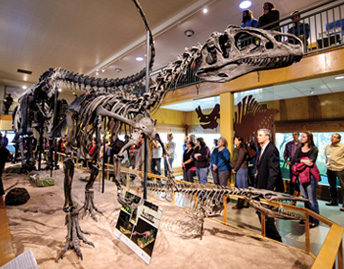
Bringing the Past to Life
October 10, 2022

Assistant Professor Briana Doering samples one of the mammoths at the Washakie Museum
and Cultural Center. (Photo by Megan Reel)
Studying ancient animals gives insight into early humans and environmental changes.
By Micaela Myers
The life of early hunter-gatherers was no picnic, but imagine the payout of bagging a 10,000-pound wooly mammoth. The earliest inhabitants of Wyoming may have done just that, luring the giant lumbering beasts into a dead end where many spears could fell them. Shortly after humans arrived on the scene, wooly mammoths became extinct. No one knows the exact cause, but professors and students at the University of Wyoming are studying mammoth kill sites in the state to learn more about the relationships between humans and mammoths.
Hunting Mammoths
“We’ve been working on sampling a group of seven mammoths that were hunted approximately 12,000 years ago in the Big Horn Basin,” says anthropology Assistant Professor Briana Doering. “We’re trying to determine exactly when the mammoths were hunted, what they ate and how far they migrated.”
At the Colby mammoth site near Thermopolis, 12,000-year-old projectile points from early humans were also discovered.
“The mammoth bones may have been cached — stored — for the winter by these Clovis people,” Doering says. They also determined that these early humans returned to the site at least twice for mammoth hunting.
“We don’t have a lot of examples of people hunting mammoths in North America, so this is pretty cool. Wyoming lays claim to this amazing example of human-animal interaction,” Doering says. “Hunting a group of mammoths requires a lot of cooperation. They probably had 10-20 people to track the mammoths, corner them and get them into an area where they could take them down.”
Doering’s team included recent master’s student Molly Herron of Littleton, Colo., and recent doctoral graduate Madeline Mackie of Yorba Linda, Calif.
Herron also worked with anthropology professors Robert Kelly and Todd Surovell and Zhaojie Zhang, director of zoology and physiology’s microscopy facility, studying ivory fragments at the 13,000-year-old La Prele mammoth kill site near Douglas. Herron is the first researcher to create a method for identifying ancient weathered and fragmented proboscidean ivory using a tabletop scanning electron microscope. Identifying the ivory was important in establishing how these early people used it and shows they considered it a valuable resource.
“The fact we have these tiny pieces all around the site is evidence that people were likely hammering on ivory tusks to use them as a raw material to make other things,” Herron says. This had not been previously well established or studied in the U.S.

Graduate student McKenna Litynski conducts experiments to determine what could cause
marks on bones discovered in Bluefish Caves (Courtesy image).
Cutting-Edge Techniques
Other anthropology students are also helping develop cutting-edge research methods, including ZooMS — zoo archaeology by mass spectrometry. Mass spectrometry determines the mass of a molecule, can provide structural information and can identify unknown components of a sample. UW is fortunate to be home to this state-of-the-art equipment. ZooMS was developed by United Kingdom researcher Michael Buckley. It uses collagen as a molecular barcode to identify bone fragments.
“You can extract collagen and use it to identify what the bone belonged to,” explains Sebastian Wetherbee of Keystone, Colo., a recent master’s graduate. “Very few labs in the world use it.” Wetherbee and fellow master’s student McKenna Litynski of Hollywood, Md., have been working through the protocols and refining methods.
“I’m interested in zooarchaeology, which is the study of animal remains at archaeological sites,” Wetherbee says. “Professor Todd Surovell studies ice age hunter-gatherers. He excavated a 12,800-year-old campsite in Colorado’s Rocky Mountains called Barger Gulch. He found a lot of little stone tools and bone, but the bone was incredibly poorly preserved. When you’re studying bones from an archaeological site, you have questions like what were they hunting and how were they impacting their ecosystem, but you can’t say anything about that if you can’t identify the bones.”
In addition to studying the bone fragments at the Barger Gulch site, Litynski hopes to use ZooMS to study the microfauna (small animals) at the La Prele site.
“There’s a debate on whether people in the Pleistocene period were specializing in mammoths or consuming a wide variety of animals, including small rodents,” she says. “I’ll also be using it to construct past environments. For me, ZooMS is important because, with microfauna, it’s really hard to get it down to the species and genus because they don’t have very distinguishing characteristics other than the teeth and the mandibles.”
Litynski is also studying bone from Canada’s Bluefish Caves.
“There’s an enormous question about when people arrived in North America,” Kelly says. “We can all agree they were here at least 13,000 years ago. The question is whether they were here earlier.”
Some believe Bluefish Caves provide evidence of 24,000-year-old human activity because of possible cut marks on the animal bones. However, natural causes for the marks could be from trampling, carnivore damage or rock fall.
“I decided to focus my research on the rock fall aspect,” she says. “I created an experiment to try and test if rocks dropped on bones could mimic stone tool cut marks.”
She dropped limestone on bones, mimicking environments in the cave, then analyzed them under a microscope.
“My results proved that in most cases the rock fall didn’t mimic cut marks,” Litynski says. “I’m currently doubling my sample size. I think it’s a really important project because of the debate on when people came to North America.”

The Apatosaurus skeleton inside the UW Geological Museum.
The People’s Collection
The UW Geological Museum moved to its current location on campus in 1956 and is beloved by visitors of all ages. Some of legendary geologist Samuel H. “Doc” Knight’s murals are still on display, and his famous copper-plated Tyrannosaurus rex welcomes all who pass.
“At one time, it was the only full-size T. rex sculpture in the U.S.,” says Geological Museum and Collections Manager Laura Vietti. “Knight deliberately used copper knowing the environment would oxidize it into a metallic dull green that’s very reptilian.”
As visitors walk in, they’re greeted by a large Apatosaurus skeleton. It was the first fully mounted dinosaur in Wyoming. Until the 1990s, the skeleton was mistakenly called Brontosaurus — the result of a mismatched head and body due to a historic mix-up by an early paleontologist in the late 1800s.
Most of UW’s fossil specimens — 1,000 specimens on display and 50,000 in their research collections — belong to the people, Vietti says. UW is a federal and Wyoming state repository, so vertebrate specimens (animals with backbones) found on federal or state lands are sent to the university.
“We ensure those specimens are cared for and stored,” Vietti says. “We make them available to researchers and have a database that is accessible. Students are actively researching a lot of these specimens.”
The museum is working with the library to create 3D models of many specimens. On display, you can see some of the earliest horse fossils in the world and the Knightia fossil fish — the Wyoming state fossil — named after Wilbur Knight, Samuel Knight’s father and a key figure in UW geology. The UW Geological Museum is the oldest museum in the state, providing key opportunities for researchers and the public to learn about Wyoming’s rich geological past.
